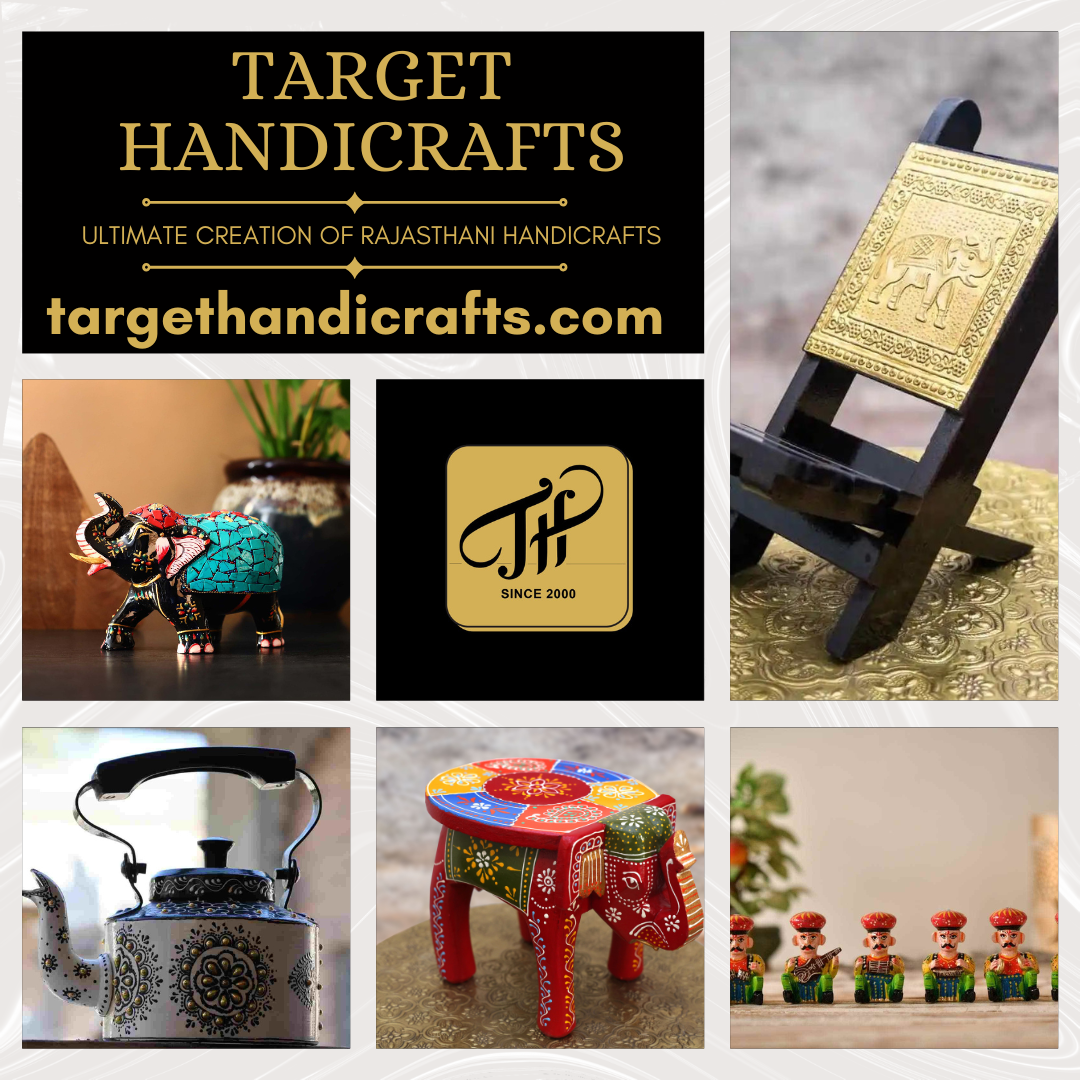India, with its diverse cultures, languages, and traditions, has a rich history of handicrafts that dates back thousands of years. Indian handicrafts are known for their intricate designs, skilled craftsmanship, and cultural significance. These crafts reflect the heritage, traditions, and artistry of different regions of the country. From textiles and pottery to metalwork and woodcarving, Indian handicrafts offer a glimpse into the nation’s vibrant and varied artistic legacy.
1. Textiles: Weaving Tradition and Art
India’s textile industry is one of the oldest in the world, producing some of the finest fabrics using traditional methods of weaving, dyeing, and embroidery.
- Banarasi Silk: Hailing from Varanasi (Banaras), Banarasi silk sarees are renowned for their fine silk, opulent zari (gold thread), and intricate designs. These sarees are often adorned with Mughal-inspired motifs such as florals, leaves, and animal figures.
- Pashmina Shawls: Originating from Kashmir, Pashmina shawls are made from fine wool and are known for their warmth and luxurious softness. These shawls are often hand-embroidered with delicate patterns and floral designs.
- Bandhani: A traditional tie-and-dye technique practiced in Rajasthan and Gujarat, Bandhani fabrics are created by tying small sections of fabric with thread before dyeing. This results in intricate patterns, often seen in sarees, dupattas, and turbans.
- Chikankari: An ancient form of embroidery from Lucknow, Chikankari involves delicate, intricate hand-stitching on lightweight fabrics like muslin, cotton, and silk. This elegant craft is often used to embellish sarees, kurtas, and scarves.
2. Pottery: Clay Art Across Cultures
Pottery is one of the earliest forms of handicrafts in India, and each region has developed its distinct style of pottery over time.
- Blue Pottery (Jaipur): Known for its vibrant blue and white designs, Jaipur’s Blue Pottery is made from quartz, making it unique among Indian ceramics. The pottery features intricate floral and geometric patterns and is used to create vases, tiles, plates, and decorative items.
- Terracotta Pottery: Terracotta, or baked earth, is an ancient Indian craft practiced across various states. Terracotta pottery from West Bengal and Uttar Pradesh is especially famous for its rustic charm and is used to create both decorative and functional items like sculptures, pots, and figurines.
- Khavda Pottery (Gujarat): This traditional craft from the Kutch region of Gujarat is known for its earthy, natural hues. Artisans use local clay and paint the pottery with natural dyes to create beautiful pots, plates, and vases.
3. Woodwork: Carving Heritage into Every Grain
India’s rich forests have provided the raw materials for intricate woodcraft for centuries. Artisans across the country have developed unique wood-carving traditions.
- Sandalwood Carving (Karnataka): Karnataka is famous for its finely detailed sandalwood carvings, used to create figurines of gods, goddesses, and animals, as well as boxes, key chains, and decorative panels.
- Kashmir Walnut Wood: In Kashmir, artisans carve intricate designs on walnut wood to create furniture, decorative items, and jewelry boxes. The motifs are often inspired by nature, with floral and vine patterns being especially popular.
- Saharanpur Woodwork: In Uttar Pradesh, Saharanpur is renowned for its woodcraft. Artisans specialize in making intricately carved wooden furniture, wall panels, trays, and boxes, often incorporating brass inlay or hand-painted designs.
4. Metal Crafts: A Fusion of Strength and Beauty
India’s metalwork is a testament to the skill and creativity of its artisans. Different regions of the country have distinct styles of metalcraft, ranging from utilitarian objects to elaborate decorative pieces.
- Brassware (Moradabad): Moradabad in Uttar Pradesh is known as the “Brass City of India,” famous for its intricate brass items like lamps, trays, figurines, and decorative items. These items are often engraved or embossed with detailed designs.
- Dhokra (Bastar): An ancient metal-casting technique, Dhokra is practiced by tribal artisans in Bastar, Chhattisgarh, and West Bengal. This craft involves the lost-wax casting technique to create metal sculptures of deities, animals, and nature-inspired forms. The rough, rustic finish is part of Dhokra’s charm.
- Bidriware (Karnataka): Originating from Bidar in Karnataka, Bidriware is a unique craft that involves inlaying silver or gold on blackened metal (usually zinc or copper). The intricate designs often feature floral and geometric patterns.
5. Stone and Marble Carving: Transforming Stone into Art
India’s stone-carving traditions date back to ancient times and are evident in its magnificent temples, sculptures, and monuments.
- Marble Inlay Work (Agra): Inspired by the Mughal-era Taj Mahal, artisans in Agra create exquisite marble items adorned with intricate inlay work. These items, such as tabletops, plates, and vases, are embedded with semi-precious stones to form detailed floral and geometric designs.
- Soapstone Carvings: Soapstone, or softstone, is used to create beautifully carved statues, figurines, and decorative items. The carving work is especially intricate, with lattice patterns and delicate details often featured in candleholders, bowls, and miniature statues.
- Kalamkari (Andhra Pradesh and Telangana): Kalamkari is a type of hand-painted or block-printed textile, traditionally using natural dyes. The themes often include mythological scenes, deities, and flora and fauna. Kalamkari can be found in sarees, wall hangings, and home furnishings.
6. Jewelry: A Sparkling Tradition of Adornment
India’s jewelry-making tradition is as ancient as its civilization, with each region developing its unique style and technique.
- Kundan and Meenakari (Rajasthan): Kundan jewelry involves setting precious and semi-precious stones in gold foil, while Meenakari is an enameling technique used to create colorful designs on gold or silver jewelry. These forms are highly valued and often seen in wedding jewelry.
- Temple Jewelry (Tamil Nadu): Inspired by South Indian temples, Temple Jewelry is traditionally crafted in gold and used to adorn deities. The designs often depict gods, goddesses, and motifs from temple architecture.
- Jadau Jewelry (Gujarat and Rajasthan): Jadau is an ancient jewelry-making technique that involves embedding precious gems, like diamonds, rubies, and emeralds, into gold. It’s often passed down through generations and holds a special place in traditional Indian bridal jewelry.
7. Leather Craft: A Tradition of Durability and Elegance
India has a long tradition of leathercraft, particularly in states like Rajasthan, West Bengal, and Madhya Pradesh.
- Mojari (Rajasthan): Rajasthan is known for its Mojari, or traditional leather footwear. These hand-embroidered shoes are made from locally sourced leather and decorated with intricate stitching, mirrors, and beads.
- Shantiniketan Leather (West Bengal): Named after the famous town of Shantiniketan, this craft involves embossing leather to create intricate designs. Artisans use vegetable dyes to color the leather and craft items like bags, wallets, and belts.
8. Handloom Weaving
The handloom sector is a significant part of India’s cultural and economic fabric, producing some of the country’s finest textiles.
- Patan Patola (Gujarat): Patola weaving is a highly skilled and labor-intensive technique used to create double-ikat textiles, primarily sarees. The intricate geometric patterns and rich colors make Patan Patola sarees prized possessions.
- Kanjivaram Silk (Tamil Nadu): Kanjivaram silk sarees are known for their durability, lustrous silk, and intricate designs. The rich gold borders and temple motifs make them popular for special occasions and weddings.
Conclusion
Indian handicrafts are a window into the country’s cultural diversity and rich artistic traditions. Each region contributes its own unique craft, techniques, and materials, creating a vast array of beautiful, functional, and artistic items. These crafts not only reflect India’s heritage but also provide livelihoods to millions of artisans across the country. Today, Indian handicrafts are celebrated globally for their craftsmanship and continue to evolve while preserving the essence of traditional artistry.



